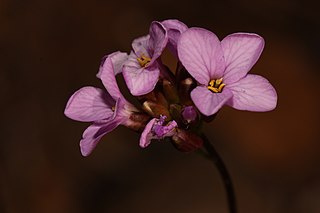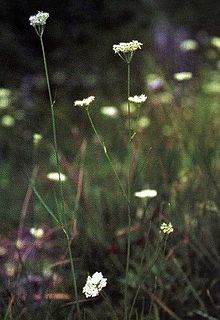
Hesperolinon is a genus in the family Linaceae, whose common genus names are dwarf-flax or western flax, in reference to their distribution along the west coast of North America. There are 13 known species within this genus of wildflowers, most of which are limited to serpentine soil habitats within California, United States. These annual plants are thought to be mostly self-pollinating.

Hesperolinon micranthum is a species of flowering plant in the flax family known by the common name smallflower dwarf flax. It is native to the west coast of North America from Oregon to Baja California. It may occur in Nevada. It grows in a number of open habitats, often on serpentine soils. This is a spindly annual herb producing a very thin stem 5 to 20 centimeters in height. Its small, sparse leaves are linear in shape. The tiny flowers have five white or pink-veined white petals each less than four millimeters long and protruding stamens with white or purple anthers.
Hesperolinon tehamense is a rare species of flowering plant in the flax family known by the common names Tehama County western flax and Paskenta Grade dwarf flax. It is endemic to northern California, where it is known from only about ten occurrences, mostly within Tehama and Glenn Counties. Most of its habitat is on Bureau of Land Management lands and within the Mendocino National Forest, in chaparral ecosystems with serpentine soils. The plant produces thin, hairy stems up to 50 centimeters in maximum height with small, sparse linear leaves. The inflorescence bears several small flowers with pale to bright yellow notched petals just a few millimeters long.

Allium munzii is a rare species of wild onion known by the common name Munz's onion.

Arabis aculeolata is a species of flowering plant in the mustard family known by the common name Waldo rockcress. It is native to a small range in the mountains of southern Oregon, where it is an uncommon member of the serpentine soils flora. Reports of its occurrence in Del Norte County, California are unconfirmed.

Astragalus agnicidus is a rare species of milkvetch known by the common name Humboldt County milkvetch. It is endemic to northern California, where it is known only from two populations in Humboldt County and one in Mendocino County.

Camelina microcarpa is a species of flowering plant in the mustard family known by several common names, including littlepod false flaxlesser gold-of-pleasure and small seed false flax. It is native to Europe and Asia, and it is common across the globe as an introduced species and sometimes a noxious weed. It is known as a weed of grain crops such as wheat and rye. This is an erect annual herb producing a branched or unbranched stem 30 centimeters to one meter in height. It is sometimes coated thinly in hairs, particularly on the lower part. The leaves are lance-shaped to oblong. The upper part of the stem is occupied by an inflorescence of many pale yellow flowers. They yield plump oblong to rounded fruits, each under a centimeter long and held at the tip of a short pedicel.
Chaenactis alpigena is a species of flowering plant in the daisy family known by the common name southern Sierra pincushion. It is native to the High Sierra Nevada and the White Mountains of California, extending in the latter just into Nevada.

Hesperolinon disjunctum is a species of flowering plant in the flax family known by the common name Coast Range dwarf flax. It is endemic to California, where it has a disjunct distribution along the North and Central Coast Ranges.
Boechera dispar is a species of flowering plant in the family Brassicaceae known by the common name pinyon rockcress. It is native to eastern California and western Nevada, where it grows in rocky areas in desert and mountain habitat. This is a perennial herb growing from a branching caudex. It produces several erect stems reaching 10 to 25 centimeters tall. The leaves are mostly located about the caudex. They are linear to lance-shaped, coated in white hairs, and one or two centimeters long. The flowers have purple petals. The fruit is a long, narrow, hairless silique up to 7 centimeters long containing round, winged seeds.

Linum grandiflorum is a species of flax known by several common names, including flowering flax, red flax, scarlet flax, and crimson flax. It is native to Algeria, but it is known elsewhere in Northern Africa, Southern Europe and in several locations in North America as an introduced species. It is an annual herb producing an erect, branching stem lined with waxy, lance-shaped leaves 1 to 2 centimeters long. The inflorescence bears flowers on pedicels several centimeters long. The flower has 5 red petals each up to 3 centimeters long and stamens tipped with anthers bearing light blue pollen. It can on occasion be found as a casual well outside its normal established range; records from the British Isles, for example, are reasonably frequent but, grown as an annual, it rarely persists for more than one season.
Perideridia bacigalupii is an uncommon species of flowering plant in the family Apiaceae known by the common names Mother Lode yampah and Bacigalupi's perideridia. It is endemic to California, where it is known only from the northern and central Sierra Nevada foothills. It is a member of the flora in chaparral and pine woodlands. It is a perennial herb which may exceed 1.5 meters in maximum height, its slender, erect stem growing from tubers. Leaves near the base of the plant have blades up to 40 centimeters long which are divided into many narrow subdivided lobes. Leaves higher on the plant are smaller and less divided. The inflorescence is a compound umbel of many spherical clusters of small white flowers. These yield ribbed, oblong-shaped fruits about half a centimeter long.

Perideridia bolanderi is a species of flowering plant in the family Apiaceae known by the common name Bolander's yampah. It is native to the western United States, where it grows in many types of habitat. It is a perennial herb which may approach one meter in maximum height, its slender, erect stem growing from tubers measuring up to 7 centimeters long. Leaves near the base of the plant have blades up to 20 centimeters long which are divided into many subdivided lobes of various sizes and shapes; the terminal segments are usually lined with teeth. Leaves higher on the plant are smaller and less divided. The inflorescence is a compound umbel of many spherical clusters of small white flowers. These yield ribbed, oblong-shaped fruits about half a centimeter long. The Atsugewi and Miwok of California used the tuberous roots of this plant for food.

Perideridia kelloggii is a species of flowering plant in the family Apiaceae known by the common name Kellogg's yampah. It is endemic to California, where it is known from the north and central coasts, the San Francisco Bay Area, and the Sierra Nevada foothills. It grows in grassland habitat, sometimes on serpentine soils. It is a perennial herb which may reach 1.5 meters in maximum height, its slender, erect stem growing from a cluster of long, narrow, fibrous roots each up to 15 centimeters long. Leaves near the base of the plant have blades up to 45 centimeters wide which are divided into many leaflets subdivided into narrow, elongated lobes. The inflorescence is a compound umbel of many spherical clusters of small white flowers. These yield ribbed, oblong-shaped fruits each about half a centimeter long.
Perideridia lemmonii is a species of flowering plant in the family Apiaceae known by the common names Lemmon's yampah and tuni. It is native to the western United States, where it is known from southeastern Oregon, western Nevada, and the mountains of eastern California. It grows in meadows, forests, and other habitat. It is a perennial herb approaching one meter in maximum height, its slender, erect stem growing from usually a single small tuber about 1.5 centimeters long. Leaves near the base of the plant have blades up to 30 centimeters long divided into one or two pairs of leaflets, each of which may be subdivided. The inflorescence is a compound umbel of many spherical clusters of small white flowers. These yield ribbed, round or oblong-shaped fruits each under half a centimeter long.

Perideridia parishii is a species of flowering plant in the family Apiaceae known by the common name Parish's yampah. It is native to mountainous regions of the southwestern United States, where it grows in forests and other habitat. It is a perennial herb growing up to 90 centimeters tall, its slender green stem growing from a small tuber. Leaves near the base of the plant have blades 10 to 20 centimeters long divided into pairs of leaflets, which may be subdivided or lobed. The inflorescence is a compound umbel of many spherical clusters of small white flowers. These yield ribbed, round or oblong-shaped fruits each about half a centimeter long.
Sclerolinon is a monotypic genus of flowering plants in the flax family containing the single species Sclerolinon digynum, which is known by the common name northwestern yellowflax. It is native to the western United States where it is known from Washington and Idaho through central California; however, it may now be extirpated from Idaho. It grows in seasonally wet habitat such as mountain meadows and vernal pools. This is an annual herb producing a hairless, erect stem up to 20 centimeters tall. The leaves are oval in shape, the upper ones with serrated edges. They are oppositely arranged about the stem and grow erect instead of spreading away from the stem. The inflorescence is a cyme of flowers surrounded by serrated, leaflike bracts. The flower has five yellow petals in a calyx of toothed sepals.
Amsonia tharpii is a species of flowering plant in the family Apocynaceae known by the common names Tharp's bluestar and feltleaf bluestar. It is native to New Mexico and Texas in the United States.

Polygala senega is a species of flowering plant in the milkwort family, Polygalaceae. It is native to North America, where it is distributed in southern Canada and the central and eastern United States. Its common names include Seneca snakeroot, senega snakeroot, senegaroot, rattlesnake root, and mountain flax. Its species name honors the Seneca people, a Native American group who used the plant to treat snakebite.
Peniocereus striatus is a species of cactus known by several common names, including gearstem cactus, cardoncillo, jacamatraca, sacamatraca, and dahlia-rooted cactus. It is endemic to the Sonoran Desert, where it occurs in Baja California, Sinaloa, and Sonora in Mexico and Arizona in the United States.











